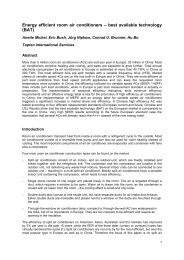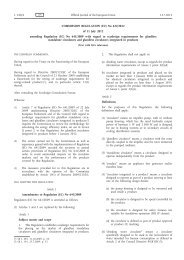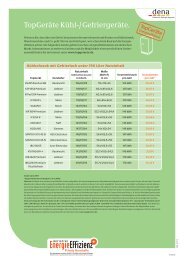Standby and off-‐mode: Recommendations for policy ... - Topten.eu
Standby and off-‐mode: Recommendations for policy ... - Topten.eu
Standby and off-‐mode: Recommendations for policy ... - Topten.eu
Create successful ePaper yourself
Turn your PDF publications into a flip-book with our unique Google optimized e-Paper software.
Best Products of Europe <br />
currently requires about 50 TWh/year to maintain network reactivity, <strong>and</strong> this should grow up to 90 <br />
TWh/year by 2020 if no action is taken. Through regulation <strong>for</strong>cing networked equipment to go to <br />
some low networked st<strong>and</strong>by modes, this additional <strong>for</strong>ecasted consumption of 40 TWh/year could <br />
be avoided cost-‐effectively. <br />
The urgency to regulate networked st<strong>and</strong>by appears very clearly in these figures. The EU must <br />
quickly finalise <strong>and</strong> adopt requirements in this field <strong>and</strong> grasp the 40 TWh per year savings potential. <br />
It is also arguable that consumption in <strong>off</strong> <strong>and</strong> passive st<strong>and</strong>by modes could be further decreased. An <br />
electricity-‐using product that is used 2 hours per day will be in st<strong>and</strong>by or <strong>off</strong> mode 8,000 hours per <br />
year. A (seemingly modest) difference of 0.5 Watt in the latter modes has a yearly consequence of 4 <br />
kWh. Applied to the 30 energy-‐using products that can be found in a typical house nowadays, it <br />
represents 120 kWh / year, which is as much as what some A+++ fridges consume yearly. <br />
Based on rough own calculations, an additional limitation of <strong>off</strong> <strong>and</strong> passive st<strong>and</strong>by in regulation <br />
1275/2008 at the level of 0.25 W would save an additional 6 to 7 TWh per year in the EU. <br />
6. Political instruments <strong>and</strong> initiatives <br />
EU Ecodesign regulations related to <strong>off</strong> <strong>and</strong> st<strong>and</strong>by modes: <br />
-‐ Horizontal Ecodesign Regulation 1275/2008/EC (see point 2 above) <br />
-‐ Revision of Ecodesign Regulation 1275/2008/EC to cover networked st<strong>and</strong>by (to come) <br />
-‐ In some other product-‐specific Ecodesign regulations, more tailored requirements have been set <strong>for</strong> <br />
the <strong>off</strong> <strong>and</strong> st<strong>and</strong>by consumption of some products. Namely: <br />
• TVs: <strong>off</strong>-<strong>‐mode</strong> is limited to 0.3 W <strong>and</strong> the requirements of the 2 nd tier of regulation <br />
1275/2008 <strong>for</strong> passive st<strong>and</strong>by have been en<strong>for</strong>ced earlier (2011). <br />
• Power supplies <strong>and</strong> chargers: the no-‐load condition is limited to 0.3 W or 0.5 W <br />
(depending on the characteristics of the device) <br />
• Washing machines <strong>and</strong> dishwashers: the consumption in st<strong>and</strong>by <strong>and</strong> <strong>off</strong> modes is <br />
included in the calculation of the energy efficiency index, which is the basis <strong>for</strong> the minimum <br />
Ecodesign requirements <br />
• Specific requirements are also excepted <strong>for</strong> Ecodesign regulations to come soon <strong>for</strong> <br />
computers, servers, tumble driers, luminaires, etc. <br />
Energy labels <strong>and</strong> consumer in<strong>for</strong>mation: <br />
In<strong>for</strong>mation to consumers on st<strong>and</strong>by consumption of products is very limited in Europe. <br />
At the point of sale, the only existing m<strong>and</strong>atory requirement is <strong>for</strong> TV <br />
manufacturers to indicate through a pictogram on the Energy Label (introduced in <br />
2011) whether models include a hard-‐<strong>off</strong> switch or quasi-‐0 Watt mode (i.e. below <br />
0.01 W). <br />
On all other existing EU Energy labels, the consumption in st<strong>and</strong>by <strong>and</strong>/or <strong>off</strong> <br />
mode is not displayed. <br />
However, manufacturers of products covered by Ecodesign regulations have to declare the passive <br />
st<strong>and</strong>by <strong>and</strong> <strong>off</strong> mode consumption of their products in the product technical fiche (e.g. <strong>for</strong> set top <br />
boxes, washing machines, dishwashers) <strong>and</strong> sometimes on free-‐access websites (e.g. <strong>for</strong> TVs, <br />
domestic air-‐conditioners, fans). But this requires from consumers to look <strong>for</strong> in<strong>for</strong>mation be<strong>for</strong>e <br />
their purchase <strong>and</strong> this is not always simple to find as this in<strong>for</strong>mation is not centralised. <br />
4










